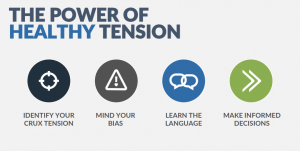Tim Arnold has spent over two decades helping organizations unite teams, spark change, and get unstuck, with clients that include The United Nations, Citibank, KPMG, Toyota, and Siemens.
Drawing on his experiences launching successful businesses, social enterprises, and community development programs, he brings a real-world perspective to his clients. With advanced degrees in both business and social justice, he helps organizations pursue both profit and purpose. Tim is the author of the bestselling book, The Power of Healthy Tension: Overcoming Chronic Issues and Conflicting Values.
Beyond leadership and team development, Tim is an avid outdoorsman, world traveller, and a bad hockey player. His biggest accomplishments are being a dad to Declan and Avryl, and husband to Becky.
Healthy Tension
From an early age we are taught that the issues and problems we see have right and wrong answers. To get good grades in school, for instance, we must get more right answers than wrong ones on quizzes and evaluations. Then we enter the work world by trying to choose the right career path or work for the right company. Thus we are programmed to approach everything in a right versus wrong or a binary way. And we become skilled problem solvers always looking to make the right decisions.
Tim suggests that the difference between problems and tensions is that tensions are persistent and should not be solved. They often emerge when two concepts, ideas or points of view exist in conflict (or in balance) on an ongoing basis.
He emphasized that as leaders we need to be good problem solvers AND we need to become more skilled at tension management. Sadly, research points to the fact that most leaders are severely under-equipped in tension situations.
Healthy tension is the type of tension that we choose to not only to accept but to embrace – to lean into – in order to engage our teams, innovate and make the best decisions possible. If we avoid healthy tension we will miss out on opportunities.
Tension is everywhere
Tim shared a story from his personal life of a trip to California with some friends to take surfing lessons. The first concept the instructor introduced was the idea that water doesn’t just move into shore, but there is an equal and opposite amount of water moving back out constantly. This is called riptides or undertow and can be very dangerous to the inexperienced. However, the more experienced surfers will use the rip currents to their advantage. This is an excellent metaphor for tension, the constant movement of water in and out, but also for the idea that as leaders we can develop skills to use the tension to our advantage.
When asked about business examples, Tim shared the fact that many tensions in organizations are common worldwide. Planning versus flexibility, quality versus cost, tasks versus relationships and capacity (supply) versus demand are almost always present in companies.

Tension also exists between people when they hold different viewpoints on a topic or an issue. Whenever you see persistent “tug-of-war” conversations where one side is trying to convince the other, that is a sign of tension.
Building Tension-Management Skills
Through his extensive research and assignments, Tim has developed a four-step process to help leaders become skilled in managing healthy tension. The model is fully explored in his book mentioned above, but today he gave us a few quick insights. The four steps are:
- Identify Your Crux Tension – the first step is to identify the primary tensions that always seem to recur and create the most anxiety for yourself and your organization. It could be departmental conflicts between sales and manufacturing, human resources and finance, or even head office versus the field. Or it might be individual styles like big-picture versus detail-oriented, competitive versus collaborative or rash versus indecision. It is very individual, and leaders need to target those that create the most negativity and stress. Identifying the tensions that surround us doesn’t mean we should remove it. The power of healthy tension is embracing it, letting it continue and using its benefits.

- Mind Your Bias – we all have opinions and biases, and because we are programmed for binary thinking, we assume that opinions different than our own must be wrong. We are typically drawn to people and information that supports our views (confirmation bias) and negate or put up walls with people from other camps. This limits the diversity of thinking and causes opportunities to be missed. As Adam Grant says, “we want cheerleaders, but we need challengers.” We need to surround ourselves with people that have different opinions and points of view from our own.
- Learn the Language – language matters, and a leader skilled in managing healthy tension will use the right words. Replacing “but” with “and” is a classic example. Tim also suggested the power of phrases like, “help me understand…” as a great tactic when you feel yourself or someone else digging in their heels on a point of view. In fact, research shows that the more we try to convince or persuade someone of our point of view, the less open they are to it.
- Make Informed Decisions – Everything changes when people realize that tensions are not things to be solved. Like a good workout, it is the constant struggle against the opposing force that builds strength. As Tim writes on his website, “Conversations that were once avoided are now being had in a respectful and impactful way. Teammates that were once polarized and divided start to become powerful allies. Goals and objectives that seemed impossible start to become achievable. Positive change that would have been once feared and avoided is now embraced in a wise and confident way.”
Take Your Business to the Next Level
At Results we care about your success, we understand how overwhelming it can feel to run a business, and we’re here to help. Reach out to Nicole through our contact form for ways to unleash the potential of your business.
Visit the Unleashed Podcast Library where you’ll find exclusive conversations with world-class thought leaders, authors, and leadership experts.
Each episode of Unleashed is hosted by Results’ CEO Jeff Tetz who spends most of his day exploring what makes high performers tick and helping build a community of leaders who want to learn and grow together. Follow Jeff (Twitter; LinkedIn; Instagram) for more great leadership insights.
You can view the entire Unleashed episode below, and here you can download the SLIDES and HANDOUT that Tim showed in the presentation.


